| Jerusalem |
| City of David |
| Conservation Maintenance |
| Orderer | Elad Association |
| Duration | August 2010 - January 2011 |
| Implemented by: |
Evgeny Ivanovsky
Amit Rosenblum
|
The City of David, which has been the object of ongoing excavations from the end of the nineteenth century until the present, is among the most bustling tourist destinations in Jerusalem. Besides the natural weathering processes and the destruction that has occurred throughout history, there is now the added factor of wear caused to the finds due to the stream of visitors to the site. This fact has increased the need to implement preventive maintenance in order to protect the remains.
In 1996 the Conservation Department of the Israel Antiquities Authority implemented a conservation project in the region of Walls D and E and in 2006 conservation work was carried out in the vicinity of the visitor’s center. The current initiative of conducting maintenance measures in the City of David is a joint effort on the part of the Nature and Parks Authority, the City of David Association, which manages the site, and the Conservation Department of the Israel Antiquities Authority, which is the chief planner and contractor of the conservation work at the site.
The work was divided into sub-areas because of the size of the site. Most of the work that has been done is connected to conservation maintenance; however, a number of measures were also undertaken that were designed to promote deeper intervention in the conservation of the site, such as the documentation of finds and monitoring the state of preservation.
The maintenance measures were carried out in order to ensure the integrity of the finds over time, without changing their character. These measures are not a substitute for comprehensive conservation action that is incorporated with the tourism development planning.
Historical-Archaeological Overview
The City of David extends across the spur known as the Ophel, which is the southeastern hill of the Old City basin. The hill rises to an elevation of c. 743 m above sea level, and is today located south of the Old City wall and the Temple Mount, in the heart of the Silwan neighborhood (Fig. 1).
The thirteen research expeditions that have excavated there since the nineteenth century bear witness to the great interest there is in the site. Noteworthy among these archaeological expeditions are those of Warren (1867); Macalister and Duncan (1923-1925); Kenyon (1961-1967); Shiloh (1978-1985); Reich and Shukron (1995-2010) and Mazar (2005-2006). Archaeological excavations are still being conducted at the site today and measures are being taken to preserve the finds and display them to the public.
The earliest remains uncovered at the site date to the Chalcolithic period. Numerous remains ascribed to the Middle Bronze Age II were exposed including: the city’s eastern wall, tamped chalk floors (Fig. 2) and a rock-hewn channel that leads from the city to the Gihon Spring outside the city wall. This channel was revealed by Warren in the late nineteenth century.
Area G in the City of David contained some of the most important finds dating to the Iron Age I-II that were ever discovered. The finds exposed in this excavation area include a stone stepped structure (Fig. 3), four-room houses and a government ‘administrative center’ (see Shiloh Y. 1984). Here we are witness to changes that occurred in the size of the city during the Iron Age. The most significant change took place in the eighth century BCE, probably in the wake of the destruction of the Kingdom of Israel, when many refugees arrived in the region. It was at this time that the city expanded to the west, to the regions we today refer to as the Jewish Quarter, Armenian Quarter and Mount Zion. During this period Hezekiah rebuilt the city wall and quarried the channel (‘Warren’s Shaft’) used to convey water from the Gihon Spring into the fortified city. All of this was apparently done in the wake of the Assyrian threat to the city (biblical references: Isaiah 22: 9-11; Kings II 20:20; Chronicles II 32). The ‘Siloam inscription’, which describes the channel quarrying project, was revealed at the site and a replica of it is there in its place today (the original inscription is on display in the archaeological museum in Istanbul, Turkey).
The city was vanquished in 586 BCE. Much evidence of the destruction has been found in the excavations. The most important evidence discovered is the ‘Burnt Room’, which was uncovered in Area G. A destruction layer was revealed in the building, which contained a large number of arrowheads and charred remains.
The settlement there was renewed during the Second Temple period. The destruction of the Temple also included the City of David. Hadiran, who rebuilt Jerusalem and changed its name to Aelia Capitolina (135 CE), did not include the City of David within its precincts.
Jerusalem grew in the Byzantine period and included the City of David. The important find from this period are the church remains that probably date to the fifth century CE.
In 638 CE the Muslims conquered the city. No significant remains dating to this period or later were discovered in the excavations.
Architectural and Technological Description
Most of the remains treated at the site date to the Middle Bronze Age II and Iron Age. The architectural remains are built of limestone consisting of fieldstones or partially dressed stones. The mortar used by the builders was composed of soil. The fortification elements that were treated (Area A, D and E) are built of large stones that are fieldstones or partially dressed stones and here too the mortar was soil-based. The stone utilized in the construction is indigenous limestone (Figs. 4, 5).
The conservation intervention included, among other things, treatment of the following special remains:
A. Tamped chalk floors dating to the Middle Bronze Age II. The floor levels were hewn in the natural bedrock and a layer of crushed chalk was deposited on them.
B. Water installations that date to the Second Temple, Byzantine and Early Islamic periods.
C. An installation made of small fieldstones, most of which is treated with light gray, lime-based plaster (Fig. 6). The researchers do not know what the function was of the installation.
D. Steps in the Siloam Pool that date to the Second Temple period (Fig. 7).
E. The entrance structure to Warren’s Shaft. This is a historic building that was probably constructed during the nineteenth century CE. This strucutre is made of ashlar stones and lime-based mortar.
Evaluating the Significance of the Site
The City of David is one of the best known and culturally important sites to the Jewish people. It is here that the Bible ends, the cultural and religious “book of books” of the Jewish people.
After 1967, as archaeological research evolved and tangible finds that corroborate the bible were exposed, the City of David became an important element in sensing the connection between the contemporary Israeli experience and the distant biblical past.
The finds from the excavation in Area G in the middle of the site have provided us with tangible evidence that the Babylonians destroyed the city in 586 BCE. This destruction and the destruction of the Second Temple became events that are rooted in the collective memory of the Jewish Diaspora and became formative events in the building of the nation in Israel.
Seal impressions were discovered in Area G and the area of the visitor’s center. One of those uncovered in the ‘House of the Bullae’ shows that it belonged to Gemaryahu son of Shaphan, who was a scribe during the reign of Jehoiakim (Jeremiah: 36). Two other impressions that were exposed bear the names of two ministers: Gedaliah Ben Pashchur and Yehuchal Ben Shelamayahu, who were active during the reign of Zedekiah (Jeremiah 38:1-4). These finds link the Israeli experience of today with the biblical period, and the Jewish people with Jerusalem.
The Religious Aspect
1. Judaism - the site is attributed to King David, who united the tribes of Israel, established Jerusalem as his seat and made it the kingdom’s capital. The image of David has accompanied the Jewish people throughout the ages; he is identified with the concept of 'repentance', as well as having written the Book of Psalms and purchased the threshing floor from Araunah, which is the Temple Mount upon which the Temple was built.
2. Christianity – the Christians view the Bible as an ‘old testament’. For them this is a sacred scripture and therefore any tangible connection to the Old Testament bears deep religious significance.
According to the New Testament Jesus was a descendant of the House of David.
Remains of a church dating to the 5th century CE were uncovered at the site. It seems that this church was built because of the story of the miracle said to have occurred near the Siloam Pool, whereby Jesus healed a blind man (John 9: 1-7).
The Technological - Engineering Aspect
Fortifications. There is evidence in the City of David concerning the construction methods and fortifications in Middle Bronze Age II and the Iron Age. Some of the Bronze Age fortifications are made of enormous stones (Area A). The massive fortifications (Area G) of the Iron Age were built under difficult topographical conditions and have managed to survive until today.
The Water System (‘Warren’s Shaft’). The water system presents an impressive engineering project. It was constructed in two main phases: in the first phase, dating to the Middle Bronze Age II, the bedrock that led to a storage pool outside the city walls was hewn. This passage was quarried in soft limestone known as meleke. In the second phase, dating to the eighth century BCE and attributed to King Hezekiah (Kings II 20: 20), quarrying was done in order to reach the water of the Gihon Spring without leaving the precincts of the enclosed city. This phase of the water system was hewn in hard limestone bedrock. Reich and Shukron have recently contended that the shaft was not used (2007).
The Physical Problems at the Site and their Causes
Most of the physical problems at the site are associated with natural weathering and erosion processes. As previously mentioned, soil-based mortar was used extensively during the Middle Bronze Age and Iron Age. Only a few of the finds from later periods were built with lime-based bonding materials.
The following are amongst the most common problems encountered at the site:
• Disintegration and crumbling of mortar or mortar that is missing from the stone joints.
• Missing building stones.
• Vegetation taking root in the building remains.
The preservation problems were caused as a result of natural weathering processes acting on the building materials. These processes were accelerated by the exposure of the remains to the elements (changes in temperature, rain, high winds, erosion and heat waves).
In addition, the lack of routine conservation maintenance and the physical damage caused by the large numbers of visitors arriving at the site have resulted in the deterioration in the preservation of the remains.
The Conservation Measures
Conservation maintenance at the site included:
• Stabilizing walls: cleaning and pointing up joints with soil-based mortar (Fig. 8).
• Stabilizing stones: stabilizing loose stones with soil-based mortar (Fig. 9).
• Completing missing stonework: completing stonework and stabilizing it with soil-based mortar.
• ‘Debesh’ built supports: construction utilizing small fieldstones and soil-based mortar (Fig. 10).
• Stabilizing the tops of walls: construction utilizing small and medium fieldstones and soil-based mortar.
• Stabilizing tamped chalk floors (Visitor’s Center sub-site): applying sacrificial layers to the chalk floors, utilizing soil-based plaster. Rice paper is installed to form a layer that separates the original tamped chalk floor level and the new sacrificial layer (Fig. 11).
• Stabilizing the plaster in the water installations (Visitor Center sub-site): applying lime-based mortar to the edges of the plaster and filling lacunae.
• Steam cleaning the steps (Siloam Pool sub-site) (Fig. 12, 13).
• Monitoring (Warren's Shaft sub-site): installing gauges for the purpose of monitoring and diagnosis.
• Weeding and removal of vegetation: conducted in all the sub-sites (Fig. 14).
• Spraying the vegetation with an herbicide (Gerlon and Round-Up) (Fig. 15).
Summary
The City of David is one of the most visited sited in Israel today. In 2008, for example, 400,000 people visited the site. The values embedded at the site and the historical evidence hidden within its finds are of profound significance as regards the Jewish people’s existence in Jerusalem.
Further conservation maintenance at the site is essential to protect the finds at the present time, to preserve them and bequeath them in an appropriate physical condition to future generations.
List of References
• Mazar E. 2007. Preliminary Report on the City of David Excavations 2005 at the Visitors Center Area. Shoham Publications.
• Mazar E. 2009. The Palace of King David. Excavations at the Summit of the City of David, Preliminary Report of Seasons 2005-2007. Shoham Publications.
• Reich, R., Shukron E. and Lernau O. 2007. Recent Discoveries in the City of David Excavations - Jerusalem, Qadmoniot 133: 32-40.
• Shiloh Y. 1984. Excavations at the City of David I: 1978-1982. Qedem Volume 19.
Additional references
City of David - archaeological appendix for the local master plan
---------------------------
Amit Rosenblum, August 2011
To view the figures, click on the figure caption
|
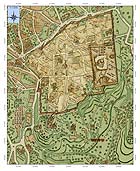 |
Map of the City of David and the Old City
|
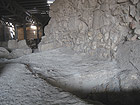 |
Fig. 2. A tamped chalk floor before intervention (Photo: A. Rosenblum)
|
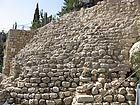 |
Fig. 3. Area G, the stepped stone structure (Photo: A. Rosenblum)
|
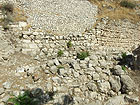 |
Fig. 4. Area A, prior to intervention (Photo: E. Ivanovski)
|
 |
Fig. 5. Areas D and E, after intervention (Photo: A. Rosenblum)
|
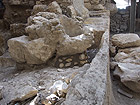 |
Fig. 6. The Visitors Center, an installation from the Second Temple period, after intervention (Photo: A. Rosenblum)
|
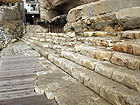 |
Fig. 7. Siloam Pool, after intervention (Photo: A. Rosenblum)
|
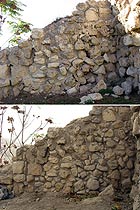 |
Fig. 8. Areas D and E, a section of wall before and after intervention (Photo: A. Rosenblum)
|
 |
Fig. 9. Area G, a section of wall before and after the intervention (Photo: A. Rosenblum)
|
 |
Fig. 10. Area G, a section of a staircase on top of ‘debesh’ fill, before and after intervention (Photo: A. Rosenblum)
|
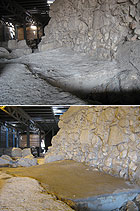 |
Fig. 11. Tamped chalk floor in the Visitors Center, before and after treatment (Photo: A. Rosenblum)
|
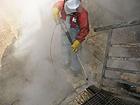 |
Fig. 12. Siloam Pool, steam cleaning (Photo: A. Rosenblum)
|
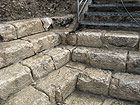 |
Fig. 13. Siloam Pool, a section of stairs after cleaning (Photo: A. Rosenblum)
|
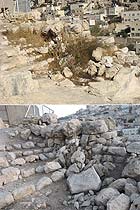 |
Fig. 14. Weeding (Photo: A. Rosenblum)
|
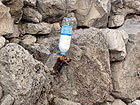 |
Fig. 15. Area A, treating the vegetation with the herbicide Gerlon (Photo: A. Rosenblum)
|
|


